Superfund Sites in Reuse in North Carolina
If you are having trouble viewing the map in your browser, click the 'View larger map' link below
Aberdeen Pesticide Dumps
The Aberdeen Pesticide Dump Superfund site occupies about 33 acres near Aberdeen in Moore County, North Carolina. The site includes a former pesticide formulation plant (the Farm Chemicals Area) and four waste disposal areas. The waste disposal areas include the Twin Sites Area, the Fairway Six Area, the McIver Dump Area and the Route 211 Area. Pesticide formulation and related waste disposal practices contaminated groundwater, soil, sediment and surface water. Between 1985 and 1989, EPA and the responsible parties conducted cleanup activities at the five site areas. Cleanup included the removal of contaminated soil, demolition of contaminated buildings and groundwater cleanup. In 1989, EPA added the site to the Superfund program’s National Priorities List (NPL). Soil cleanup is now complete. Water treatment and monitoring is ongoing. The Farm Chemicals Area is now home to an industrial and construction supply store, a gourmet coffee roaster and a commercial mini-storage warehouse facility. The Twin Sites Area now provides recreational opportunities to the local community, supporting a municipal walking trail, pedestrian bridge and fishing in Pages Lake.
For more information:
Barber Orchard
The 438-acre Barber Orchard Superfund site is located just outside of Waynesville, North Carolina. From 1908 to 1988, Barber Orchard grew apples for commercial markets. The growers used various pesticides and insecticides on trees and fruit. The growers pumped these chemicals throughout the property using an underground piping system. After foreclosure on the site property in 1988, the bank divided the site into several parcels and sold them for various uses. In the late 1990s, site investigations found that the long-term use of pesticides and leaking pipes on the property contaminated soil and groundwater. From 1999 to 2001, EPA and the North Carolina Department of Environment and Natural Resources (NCDENR) removed contaminated soil from the yards of 28 homes. EPA added the site to the Superfund program’s National Priorities List (NPL) in September 2001. In 2004 and 2005, the Town of Waynesville connected 32 parcels at the site to the public water supply. In 2010 and 2011, EPA and NCDERNR cleaned up the remaining site contamination. Long-term groundwater monitoring is ongoing. Agricultural production, residential homes, a church, and commercial and light industrial businesses occupy portions of the site. EPA expects that most of the currently undeveloped land at the site will be developed as a residential area.
For more information:
Benfield Industries, Inc.
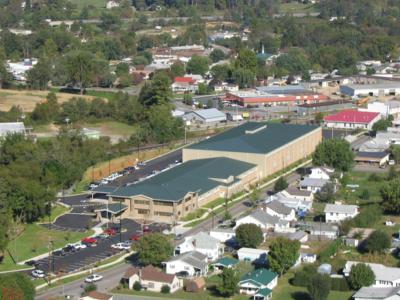 Benfield Industries, Inc.The 6-acre Benfield Industries Superfund site is located Waynesville, North Carolina. From 1971 until 1983, Benfield Industries mixed and packaged bulk chemicals for resale at the site. The facility handled and stored paint thinners, solvents, sealants, cleaners, de-icing solutions and wood preservatives. In 1982, a fire destroyed most on-site structures and ended operations. After the fire, the North Carolina Department of Human Resources (NCDHR) ordered the facility owner to remove all debris and cover the site with clean soil. A state inspection in 1985 found that site activities contaminated soil and groundwater. EPA added the site to the Superfund program’s National Priorities List (NPL) in 1989. EPA performed additional cleanup activities at the site, including removal and treatment of contaminated soil and groundwater treatment. After EPA completed soil cleanup activities, Haywood Vocational Opportunities (HVO) showed interest in purchasing the vacant site property to expand its facilities. The company is the largest manufacturer of custom medical drapes in the United States. HVO also provides employment opportunities and job training to persons with disabilities. EPA worked closely with HVO to address the company’s concerns, leading to HVO’s purchase of the site property at auction in 2002. The company built its new manufacturing and training facilities on 4 acres. The company designated 2 acres for green space. HVO completed the site’s redevelopment in 2004. Today, HVO is the fifth largest employer in the county. In 2013, EPA awarded the company with an Excellence in Site Reuse Award for outstanding efforts in the redevelopment of a Superfund site.
Benfield Industries, Inc.The 6-acre Benfield Industries Superfund site is located Waynesville, North Carolina. From 1971 until 1983, Benfield Industries mixed and packaged bulk chemicals for resale at the site. The facility handled and stored paint thinners, solvents, sealants, cleaners, de-icing solutions and wood preservatives. In 1982, a fire destroyed most on-site structures and ended operations. After the fire, the North Carolina Department of Human Resources (NCDHR) ordered the facility owner to remove all debris and cover the site with clean soil. A state inspection in 1985 found that site activities contaminated soil and groundwater. EPA added the site to the Superfund program’s National Priorities List (NPL) in 1989. EPA performed additional cleanup activities at the site, including removal and treatment of contaminated soil and groundwater treatment. After EPA completed soil cleanup activities, Haywood Vocational Opportunities (HVO) showed interest in purchasing the vacant site property to expand its facilities. The company is the largest manufacturer of custom medical drapes in the United States. HVO also provides employment opportunities and job training to persons with disabilities. EPA worked closely with HVO to address the company’s concerns, leading to HVO’s purchase of the site property at auction in 2002. The company built its new manufacturing and training facilities on 4 acres. The company designated 2 acres for green space. HVO completed the site’s redevelopment in 2004. Today, HVO is the fifth largest employer in the county. In 2013, EPA awarded the company with an Excellence in Site Reuse Award for outstanding efforts in the redevelopment of a Superfund site.
For more information:
- Reuse and the Benefit to Community: Benfield Industries Case Study (2012) (PDF) (7 pp, 365 K, About PDF)
- News Release: Haywood Vocational Opportunities, Inc. to Receive the EPA Region 4 “Excellence in Site Reuse” Award
- Superfund Site Profile Page
Bypass 601 Ground Water Contamination
 Bypass 601 Ground Water ContaminationThe 13-acre Bypass 601 Ground Water Contamination Superfund site is located in Concord, North Carolina. Martin Scrap Recycling (MSR) operated a battery salvage and scrap metal recycling facility at the site from 1966 to 1986. MSR recovered scrap metal, mostly lead, from scrap vehicle batteries. Operators collected and disposed of waste in a surface impoundment on site. MSR also used 10 other disposal locations around the city, creating additional source areas that are also part of the Superfund site. Investigations in the mid-1980s found that site operations and waste disposal practices contaminated debris, soil, sediment and groundwater with lead and volatile organic compounds. EPA placed the site on the Superfund program’s National Priorities List (NPL) in 1986. In 1992, early EPA cleanup actions included removing lead-contaminated soil and debris from four source areas and stockpiling it at the MSR facility. The site’s potentially responsible parties (PRPs) performed additional cleanup. PRP cleanup involved excavating contaminated soil, sediment and debris, stabilizing some waste materials, and placing the wastes under a cap. Cleanup also included the use of natural processes to address groundwater contamination, land and groundwater use restrictions, and groundwater monitoring. Cleanup ended in 1999. After cleanup, EPA removed seven of the 10 source areas from the NPL listing. Groundwater monitoring continues. The successful cleanup enabled the beneficial reuse of the former MSR property. Today, a storage business operates at the property. The business uses the capped area of the MSR property to park and store containers and recreational vehicles. The business office is also located on site, just outside of the cap. Cleanup also enabled continued residential and commercial uses at the 10 source areas.
Bypass 601 Ground Water ContaminationThe 13-acre Bypass 601 Ground Water Contamination Superfund site is located in Concord, North Carolina. Martin Scrap Recycling (MSR) operated a battery salvage and scrap metal recycling facility at the site from 1966 to 1986. MSR recovered scrap metal, mostly lead, from scrap vehicle batteries. Operators collected and disposed of waste in a surface impoundment on site. MSR also used 10 other disposal locations around the city, creating additional source areas that are also part of the Superfund site. Investigations in the mid-1980s found that site operations and waste disposal practices contaminated debris, soil, sediment and groundwater with lead and volatile organic compounds. EPA placed the site on the Superfund program’s National Priorities List (NPL) in 1986. In 1992, early EPA cleanup actions included removing lead-contaminated soil and debris from four source areas and stockpiling it at the MSR facility. The site’s potentially responsible parties (PRPs) performed additional cleanup. PRP cleanup involved excavating contaminated soil, sediment and debris, stabilizing some waste materials, and placing the wastes under a cap. Cleanup also included the use of natural processes to address groundwater contamination, land and groundwater use restrictions, and groundwater monitoring. Cleanup ended in 1999. After cleanup, EPA removed seven of the 10 source areas from the NPL listing. Groundwater monitoring continues. The successful cleanup enabled the beneficial reuse of the former MSR property. Today, a storage business operates at the property. The business uses the capped area of the MSR property to park and store containers and recreational vehicles. The business office is also located on site, just outside of the cap. Cleanup also enabled continued residential and commercial uses at the 10 source areas.
For more information:
Celanese Corp. (Shelby Fiber Operations)
The 450-acre Celanese Corp. (Shelby Fibers Operation) Superfund site is located in Shelby, North Carolina. Ticona, an operating subsidiary of the Celanese Corporation (Celanese), manufactures polyester resin and synthetic fibers at the site. The plant opened in 1960 and, over a 20-year period, caused widespread contamination of soil, sediment and groundwater. Facility operators dumped chemical wastes into unlined ditches and creeks, burned plant wastes in open pits, and buried waste sludge on the site. In 1986, EPA added the site to the Superfund program’s National Priorities List (NPL). EPA and the State worked with Celanese to address contaminated soil and build a system to clean the groundwater. In the mid-1990s, Celanese agreed to connect nearby residential properties to the public water supply. Groundwater monitoring is ongoing. The on-site facility continues to operate, but in a limited capacity.
For more information:
Charles Macon Lagood and Drum Storage
The 41-acre Charles Macon Lagoon and Drum Storage Superfund site is located just outside of Cordova, North Carolina. A waste oil recycling facility and antifreeze manufacturing plant operated at the site from 1979 to 1982. An EPA investigation found that site activities had contaminated soil and groundwater. Early cleanup actions performed by EPA included removing waste and oil from the site, and excavating on-site waste lagoons and refilling with clean soil. EPA added the site to the Superfund program’s National Priorities List (NPL) in 1987. In the mid-1990s, the site’s potentially responsible parties cleaned up an on-site lagoon and installed groundwater and soil vapor extraction systems. Groundwater treatment and monitoring are ongoing. Currently, the site supports residential and agricultural land uses, as well as recreational hunting and fishing activities.
For more information:
Davis Park Road TCE
The 20-acre Davis Park Road TCE Superfund site is located in Gastonia, North Carolina. The site includes residential and commercial areas affected by contaminated groundwater. In 1990, the Gaston County Environmental Health Department performed routine water sampling in a residential subdivision. The samples contained high levels of contamination. Site investigations in the early 1990s identified wastes discharged by an auto repair shop as the source of the groundwater contamination. EPA added the site to the Superfund program’s National Priorities List (NPL) in 1999. In 2000, EPA connected the surrounding residential properties to alternate water supplies. EPA also installed water treatment systems on affected wells. Long-term operation and maintenance responsibilities have been transferred to the State. Groundwater monitoring is ongoing. Currently, the Cedar Oak Park subdivision contains 20 acres of residential homes on site. Private commercial businesses also operate on site.
For more information:
FCX, Inc. (Washington Plant)
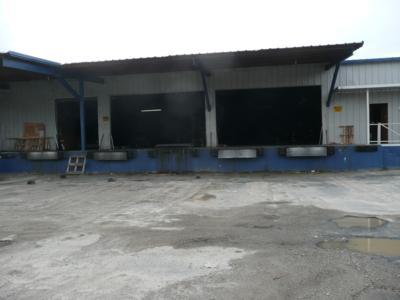 FCX, Inc. (Washington Plant)The 12-acre Farmers’ Cooperative Exchange (FCX), Inc. (Washington Plant) Superfund site is located in Washington, North Carolina. FCX operated a farm supply distribution center on site from 1945 to 1985. The distribution center repackaged and sold pesticides, herbicides and tobacco-treating chemicals. During site operations, pesticide and insecticide handling and disposal practices contaminated soil and groundwater. EPA listed the site on the Superfund program’s National Priorities List (NPL) in 1989. Cleanup included removal of contaminated soil, groundwater extraction and treatment, and monitoring the natural breakdown of groundwater contaminants. A trucking distribution company reuses the former FCX warehouse on site. In 2010, the North Carolina Department of Transportation constructed the U.S. Route 17 Washington Bypass on a portion of the site.
FCX, Inc. (Washington Plant)The 12-acre Farmers’ Cooperative Exchange (FCX), Inc. (Washington Plant) Superfund site is located in Washington, North Carolina. FCX operated a farm supply distribution center on site from 1945 to 1985. The distribution center repackaged and sold pesticides, herbicides and tobacco-treating chemicals. During site operations, pesticide and insecticide handling and disposal practices contaminated soil and groundwater. EPA listed the site on the Superfund program’s National Priorities List (NPL) in 1989. Cleanup included removal of contaminated soil, groundwater extraction and treatment, and monitoring the natural breakdown of groundwater contaminants. A trucking distribution company reuses the former FCX warehouse on site. In 2010, the North Carolina Department of Transportation constructed the U.S. Route 17 Washington Bypass on a portion of the site.
For more information:
General Electric Co./Shepherd Farm
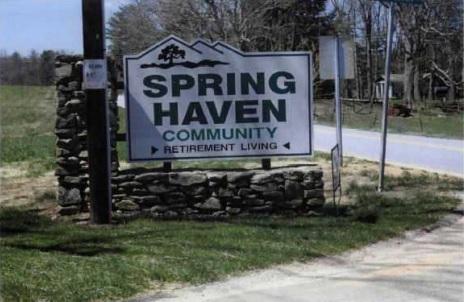 General Electric Co./Shepherd FarmThe General Electric Co./Shepherd Farm Superfund site is located in East Flat Rock, North Carolina. The site consists of two areas, or sub-sites. The General Electric (GE) sub-site covers 110 acres. The 31-acre Shepard Farm sub-site is located southwest of the GE sub-site. GE disposed of facility-related wastes at both areas. These waste disposal practices contaminated soil and groundwater with hazardous chemicals. EPA added the site to the Superfund program’s National Priorities List (NPL) in 1994. Cleanup activities included excavating and consolidating contaminated soil, as well as treating and monitoring groundwater. Additional cleanup included capping remaining soil contamination and placing land use restrictions on the site. GE completed site cleanup in 2000. EPA’s carefully selected cleanup plan allowed the continued industrial and residential use of the site throughout cleanup activities. GE Lighting Systems continues to operate a manufacturing facility and distribution warehouse on the property. The site also supports a manufactured housing community, a community center and agricultural uses.
General Electric Co./Shepherd FarmThe General Electric Co./Shepherd Farm Superfund site is located in East Flat Rock, North Carolina. The site consists of two areas, or sub-sites. The General Electric (GE) sub-site covers 110 acres. The 31-acre Shepard Farm sub-site is located southwest of the GE sub-site. GE disposed of facility-related wastes at both areas. These waste disposal practices contaminated soil and groundwater with hazardous chemicals. EPA added the site to the Superfund program’s National Priorities List (NPL) in 1994. Cleanup activities included excavating and consolidating contaminated soil, as well as treating and monitoring groundwater. Additional cleanup included capping remaining soil contamination and placing land use restrictions on the site. GE completed site cleanup in 2000. EPA’s carefully selected cleanup plan allowed the continued industrial and residential use of the site throughout cleanup activities. GE Lighting Systems continues to operate a manufacturing facility and distribution warehouse on the property. The site also supports a manufactured housing community, a community center and agricultural uses.
For more information:
Koppers Co., Inc. (Morrisville Plant)
The 52-acre Koppers Co., Inc. (Morrisville Plant) Superfund site is located in Morrisville, North Carolina. From 1896 to 1975, several lumber companies, including the Koppers Company, the Cary Lumber Company and Unit Structures Inc., operated at the site. In 1968, the Koppers Company’s wood-treating operations at the site used chemical wood preservers. Operators stored wastewater in an unlined lagoon, which eventually emptied into a pond. The company installed monitoring wells around the site. In 1980, the North Carolina Department of Health and Human Services found contamination in well water samples. People surrounding the property use groundwater and drinking water from private wells. EPA added the site to the Superfund program’s National Priorities List (NPL) in 1989. Cleanup activities included removing contaminated soil, filling the lagoons with clean soil and restoring wetlands. Cleanup also included connecting residences near the site to the public water supply. A groundwater treatment system began operating in May 1996. In 1997, EPA deleted a 33-acre portion of the site from the NPL. Unit Structures, Inc. now operates an active wood processing facility on this portion of the site.
For more information:
Martin-Marietta, Sodyeco, Inc.
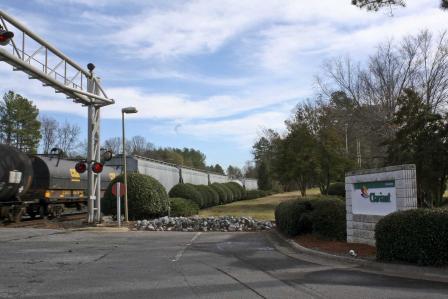 Martin-Marietta, Sodyeco, Inc.The 1,500 Martin-Marietta, Sodyeco, Inc. Superfund site is located about 10 miles west of Charlotte, North Carolina. The site was home to various chemical companies for many years, beginning in 1936. In 1982, EPA found contaminants in ground and surface waters on the site. EPA placed the site on the Superfund program’s National Priorities List (NPL) in 1983. EPA’s cleanup included capping and disposing of waste materials and soil, and treating groundwater. EPA deleted the site from the NPL in February 2012. Industrial tenants, including Monark Industrial Services, operate on part of the site. Forsite Development has begun redevelopment efforts at the site. The developer is transforming the area into EPA Region 4’s first eco-industrial park, called ReVenture Park. Infrastructure includes rail and interstate access, a wastewater treatment facility, 300,000 square feet of existing industrial space, utility substations and transmission lines, and a 360-million-gallon containment pond. In late 2013, Forsite Development began recruiting new and emerging recycling projects to the site. Alternative fuels and renewable energy technologies businesses are also welcome to the site. Projects at ReVenture range from creation of a lightweight, ballistic armor made from organic material to development of the first highway-ready, light-duty electric pickup truck. Environmental stewardship is also an integral part of the site’s redevelopment plans. A 185-acre conservation area enhances the site’s natural resources. Projects include wildlife habitat, stream restoration, and a trail system connecting the regional Carolina Thread Trail across the site to the nearby U.S. National Whitewater Center.
Martin-Marietta, Sodyeco, Inc.The 1,500 Martin-Marietta, Sodyeco, Inc. Superfund site is located about 10 miles west of Charlotte, North Carolina. The site was home to various chemical companies for many years, beginning in 1936. In 1982, EPA found contaminants in ground and surface waters on the site. EPA placed the site on the Superfund program’s National Priorities List (NPL) in 1983. EPA’s cleanup included capping and disposing of waste materials and soil, and treating groundwater. EPA deleted the site from the NPL in February 2012. Industrial tenants, including Monark Industrial Services, operate on part of the site. Forsite Development has begun redevelopment efforts at the site. The developer is transforming the area into EPA Region 4’s first eco-industrial park, called ReVenture Park. Infrastructure includes rail and interstate access, a wastewater treatment facility, 300,000 square feet of existing industrial space, utility substations and transmission lines, and a 360-million-gallon containment pond. In late 2013, Forsite Development began recruiting new and emerging recycling projects to the site. Alternative fuels and renewable energy technologies businesses are also welcome to the site. Projects at ReVenture range from creation of a lightweight, ballistic armor made from organic material to development of the first highway-ready, light-duty electric pickup truck. Environmental stewardship is also an integral part of the site’s redevelopment plans. A 185-acre conservation area enhances the site’s natural resources. Projects include wildlife habitat, stream restoration, and a trail system connecting the regional Carolina Thread Trail across the site to the nearby U.S. National Whitewater Center.
For more information:
- Redevelopment of the Martin-Marietta Sodyeco Superfund Site (PDF)(2 pp, 535 K, About PDF)
- Reclaim, Restore, Reinvent: Creating Jobs and Cleaner Energy - The Martin-Marietta, Sodyeco, Inc. Site in Charlotte, North Carolina (PDF) (16 pp, 5.7 MB)
- News Release: Forsite Development, Inc. to Receive EPA Region 4's "Excellence in Site Reuse" Award
- Superfund Site Profile Page
National Starch & Chemical Corp.
The Curtis Specialty Papers, Inc. Superfund site is located in a mixed-use area in the Borough of Milford and Alexandria Township in Hunterdon County, New Jersey. Surrounding land uses include residential, commercial/industrial, agricultural and recreational uses. The site is a former paper mill located along the Delaware River. The paper mill operated for about 90 years until 2003. The 86-acre paper mill area included buildings, a power plant and a wastewater treatment facility. As a result of poor waste handling and disposal, site soils and groundwater became contaminated. EPA added the site to the Superfund program’s National Priorities List (NPL) in 2009. EPA worked with two cooperative potential responsible parties on several early response actions to start cleaning up the site. Cleanup activities includes removal of underground and aboveground storage tanks, disposal of drums containing chemicals, and demolition of several buildings. The parties also removed lead-based paint, asbestos and contaminated upland soil. A creek discharges into the Delaware River at the northern end of the site. Cleanup efforts involved removing contaminated sediments, stabilizing the bank, and restoring the creek with native vegetation. In addition to creek restoration, a former outdoor basin area now serves as revegetated, open habitat space. In 2003, the New Jersey State Historic Preservation Office determined that the site is eligible for the National Register of Historic Properties as the Curtis Paper Mill Historical District. As cleanup continues, EPA will continue to work with site stakeholders on safe reuse of the site while preserving the site’s historic significance.
For more information:
North Belmont PCE
The North Belmont PCE Superfund site consists of two closed dry cleaning businesses in North Belmont, North Carolina. The main source of contamination is located where a dry cleaning establishment operated from 1960 to 1975. A second dry cleaning business operated prior to 1960 at the other source area. Improper disposal of waste dry cleaning solvents resulted in soil and groundwater contamination. In 1991, Gaston County Health Department sampling efforts found significant PCE contamination in a residential well. This well supplied drinking water to an elementary school and two homes. Further investigation found contamination in 16 residential drinking water wells. In 1999, EPA added the site to the Superfund program’s National Priorities List (NPL). Cleanup activities at the site included on-site groundwater treatment, connection of affected residences and businesses to a public water supply, optional wellhead treatment for affected private wells and continued groundwater monitoring. Residential properties and a few small businesses are located at the second source area.
For more information:
North Carolina State University (Lot 86, Farm Unit #1)
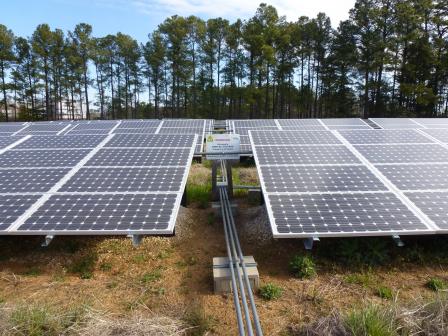 North Carolina State University (Lot 86, Farm Unit #1)The 1.5-acre North Carolina State University (Lot 86, Farm Unit #1) Superfund site is located in Raleigh, North Carolina. The site served as a waste disposal area for North Carolina State University science laboratories and agricultural research facilities. From 1969 to 1980, the University disposed of solvents, pesticides, heavy metals, acids and some low-level radioactive laboratory wastes in trenches located on a portion of the site. EPA added the site to the Superfund program’s National Priorities List (NPL) in 1986. EPA’s 1996 cleanup plan included the treatment of contaminated soil. Cleanup also included the removal and treatment of contaminated groundwater. The site’s potentially responsible party completed soil cleanup in 1999. Treatment and monitoring of contaminated groundwater continues under EPA oversight. Since 2007, Carolina Solar Energy LLC (CSE) has operated a 70 kW photovoltaic solar generation project on the site. The project has been designated a Solar "Brownfields to Brightfields" Technology Demonstration Project by the U.S. Department of Energy. CSE sells the electricity generated by the 12 solar arrays back to Progress Energy. CSE will own and operate the solar energy system for 20 years under a lease from the State of North Carolina.
North Carolina State University (Lot 86, Farm Unit #1)The 1.5-acre North Carolina State University (Lot 86, Farm Unit #1) Superfund site is located in Raleigh, North Carolina. The site served as a waste disposal area for North Carolina State University science laboratories and agricultural research facilities. From 1969 to 1980, the University disposed of solvents, pesticides, heavy metals, acids and some low-level radioactive laboratory wastes in trenches located on a portion of the site. EPA added the site to the Superfund program’s National Priorities List (NPL) in 1986. EPA’s 1996 cleanup plan included the treatment of contaminated soil. Cleanup also included the removal and treatment of contaminated groundwater. The site’s potentially responsible party completed soil cleanup in 1999. Treatment and monitoring of contaminated groundwater continues under EPA oversight. Since 2007, Carolina Solar Energy LLC (CSE) has operated a 70 kW photovoltaic solar generation project on the site. The project has been designated a Solar "Brownfields to Brightfields" Technology Demonstration Project by the U.S. Department of Energy. CSE sells the electricity generated by the 12 solar arrays back to Progress Energy. CSE will own and operate the solar energy system for 20 years under a lease from the State of North Carolina.
For more information:
Weyerhaeuser Co. Plymouth Wood Treating Plant
The Weyerhaeuser Company (Co.) Plymouth Wood Treating Plant site is located in Plymouth, North Carolina. Since 1937, a paper mill and paper products manufacturing facility has operated at the site. Past waste disposal practices at the paper mill included discharging wastewater into the Roanoke River and Welch Creek. Operators also disposed of facility-related wastes in an on-site landfill. Facility operations and these waste disposal practices contaminated groundwater, sediment, soil, surface water and fish. EPA considered adding the site to the Superfund program’s National Priorities List (NPL), but decided to address the cleanup under alternative cleanup approaches. Domtar Corporation, the current owner, leads the site cleanup with oversight from EPA and the North Carolina Department of Environment and Natural Resources. Site investigations were completed for four different areas at the site. Cleanup activities were necessary at three of the areas. Cleanup activities included capping contaminated materials, installation of a sheetpile wall below ground in an area adjacent to the Roanoke River, and a sand cap over contaminated sediments in Welch Creek. In addition, a fish consumption advisory is in place and land use restrictions are planned to limit future land uses to industrial and commercial uses. Site monitoring is ongoing. EPA’s carefully selected cleanup plan enabled the reuse of a part of the capped landfill. Today, the plant uses the gravel part of the landfill cap for offices, parking and storage of construction materials.
For more information:
